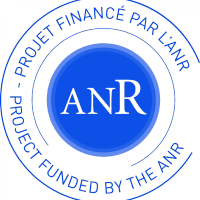Tell me about: 5G
In the "Tell me about" section, we will try to expain in a few sentences the most important aspects to fully understand the ANR-LiLit project.
On this page, you will find the specific requirements and expectations regarding the 5th Generation of Telecommunication, or 5G, and a quick rewind on the different generations that preceded.
The previous Generations of telecommunications
1G, 2G etc. are the names given to the different Generations of telecomunications that succeeded each other in the years following the first phone call given from a celullar phone. As a rule of thumb, the introduction of a new G corresponds to a change in the nature of the transmission technology and the attribution of new frequency bands.
The first generation, 1G

The first generation of telecommunications coincides with the first generation of mobile phones. It was launched as early as 1979 by NTT (Nippon Telegraph and Telephone) [1] in the region of Tokyo. It appeared in 1981 in the northern Europe, 1983 in the USA, and more generally in the early 80s for most nations.
1G used an analogic mode to transmit voice communivations and a few different standards coexisted, depending on the country. The voice messages were modulated at frequencies higher than 150 MHz to be exchanged between radio towers, heavily impacting the quality of the recordings. To that we can add that intimacy was a big concern as recordings were brodcasted in the radio towers before forwarding them [2], that the capacity was very low, it had very poor hand-off etc.
The second generation, 2G
Introduced in the late 80s, 2G distinguished itself from the previous technology in many ways. First, the voice messages now uses a digital mode of transmission, then it is based on the Global System for Mobile Communications (GSM) norm and allows to send and receive texts and pictures messages with the SMS and MMS services at a speed of a few kbps (kilobit per second).
To cope with the increase in the amount of transfered data, a few technologies were added to the GSM norm, more precisely the General Packet Radio Service (GPRS) and the Wireless Application Protocol (WAP) technologies that increased the transmission speed to 64-144 kbps but more importantly, granted for the first time in history an access to mobile internet. For these reasons, GRPS is sometimes referred to as 2.5G.
The third generation, 3G
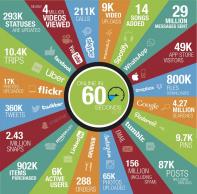
60 seconds on the internet [4]
The commercialization of the first smartphones in the early 2000s matches with the launch of 3G (UMTS in Europe, CDMA2000 in the USA). With the IMT-2000 specifications, the International Telecommunication Union (ITU) gives the objectives and the technologies selected for this new generation. The main change lies in the amelioration of the packet switching system (introduced with 2.5G) that enables to increase the speed of the transmissions to few Mbps (103 kpbs).
3G sets the stage for visio calls, or videotelephony, to television, and more broadly to high speed mobile internet.
The fourth generation, 4G
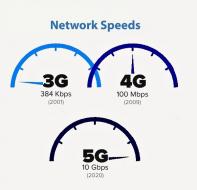
In addition to the introduction of the Long Term Evolution (LTE) and then the LTE-Advanced norms by the 3GPP consortium (created to bring merge all the different standards into a single unified international mobile telecomunications system and that defines, with the l'ITU, the objectives of the new generations of telecommunications), 4G marks a switch from the public switched telephone network (PSTN) to the voice over IP (VoIP) technology.
4G enabled the development of new mobile services thanks to greater transfer speeds that could now rival with cable connections (from a few tens of Mbps up to several Gbps (103 Mpbs)). On another note, 4G also marks a sharp increase in the installation costs and the complexity of the devices, as well as the protection of the data.
Expected benefits of 5G
Where 5G marks a turning point is that the center idea is not only to increase the data rate, but also, and more importantly, to broaden its scope to reach new sectors: health, transportation, mass media or even energy.
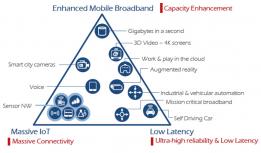 5G objectives triangle [7]
5G objectives triangle [7]
Since 2013, the ITU has been working on the new IMT-2020 standard while the 3GPP studied the different technologies capable of reaching 5G specifications. Since then, it published Release 15, 16 and 17 that provides more details regarding the different steps involved in establishing the new norm.
5G has three major objectives studied by three different working groups: the Massive Machine Type Communications (mMTC), the Enhanced Mobile Broadband (eMBB) and the Ultra-reliable and Low Latency Communications (uRLLC) [6,7].
1. mMTC – Massive Machine Type Communications
The main objective is to provide the ideal environment for the developmment of the Internet of Things (IoT): wide coverage, low power consumption and high security. 5G technologies should help to deal with the exponential increase in the number of connected objects in our surroundings.
Main targeted characteristics :
- Connection density (in number of objects/km²): 106 (105 at present)
- Network energy efficiency: x50 (x1 at present)
2. eMBB – Enhanced Mobile Broadband
This objective is linked to the development of applications that need very high data transfer rate: ultra-high definition video (8K), real-time broadcasting of content, augmented reality, 3D and virtual reality.
Main targeted characteristics :
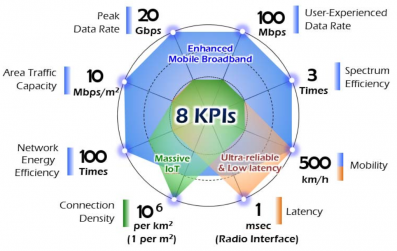 Targeted performances of the different working groups of 5G [8]
Targeted performances of the different working groups of 5G [8]- Peak data rate (in Gbps): 20 (1 at present)
- User-experienced data rate (in Mbps): 100 (10 at present)
- Spectrum efficiency (rate/bandwith ratio, in bit/Hz): x3 (x1 at present)
- Mobility (in km/h): 500 (350 at present)
- Network energy efficiency: x100 (x1 at present)
- Area traffic capacity (in Mbps/m²): 10 (0,1 at present)
3. uRLLC – Ultra-reliable and Low Latency Communications
This working group focuses on the application of 5G in industry and transportation. In these two fields, the data collected must be unequivocal, ultra-reliable and must be immediately and continuously interpretated.
Main targeted characteristics :
- Mobility (in km/h) : 500 (350 at present)
- Latency (in ms) : 1 (10 at present)
To meet all these requirements, the network will have to be flexible, and to do so, will have to be composed for the most part of agile and reconfigurable components.
In the framework of the LiLit project, the objective is to prove the technical capability to fabricate a radio frequency filtering device that would work at 5,890 GHz with a bandwidth larger than 10%. This way, the device could be implemented in any application that works between 3 and 6 GHz with only a few changes in its architecture.
[1] Hilbert, Jeffrey L. Tunable RF Components and Circuits: Applications in Mobile Handsets. CRC Press, 2015.
[2] Gawas, A. U. "An overview on evolution of mobile wireless communication networks: 1G-6G." International Journal on Recent and Innovation Trends in Computing and Communication 3.5 (2015): 3130-3133.
[3] http://www.cntr.salford.ac.uk
[4] https://www.ericsson.com/res/docs/2014/5g-what-is-it-for.pdf
[5] https://www.sicomtesting.com/fr/blog/dal-1g-al-5g-il-passato-e-il-futuro-degli-standard-gsm-umts-hspa-ed-lte/
[6] https://www.arcep.fr/uploads/tx_gspublication/rapport-enjeux-5G_mars2017.pdf
[7] http://5g.ieee.org/standards
[8] https://5g-ppp.eu/wp-content/uploads/2016/11/06_10-Nov_Session-3_Lee-JunHwan.pdf
Vincent Astié, 09/19

